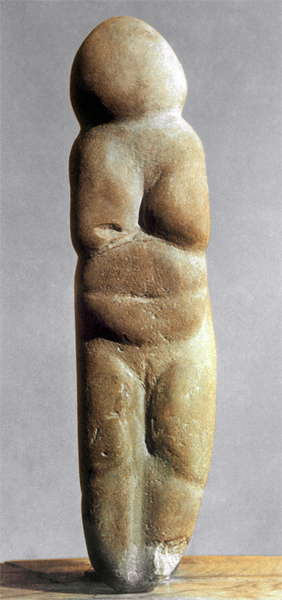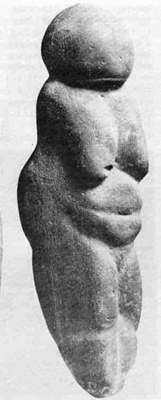Back to Don's Maps
Back to Venus figures from the Stone Age
The Chiozza Venus from Italy

During the excavation of some Eneolithic graves (Chalcolithic equivalent to the transition period between the Neolithic and Bronze Age) in the clay pit of Chiozza, near Scandiano (Reggio Emilia), that is to say, in a region that is not dissimilar to that of Savignano, a new female statuette was discovered in 1940. But, like Savignano, the statuette of Chiozza was collected in a formation of Holocene alluvial deposits, and it is impossible to objectively determine its age.
Following this discovery, new excavations were carried out in 1941 by Pia-Laviozza Zambotti, but this effort did not furnish any extra information that could indicate the age of the statue. It would seem that either hypothesis could be selected: either it is Paleolithic and is not in its position of origin, or it is Eneolithic.
The statue is carved on Chiozza hard brown sandstone which includes feldspar and mica, and is of a size substantially equivalent to that of Savignano, with a height of 205 mm, a maximum width of 50 mm and a maximum thickness of 60 mm. The head is subspherical, and carries no detail. The neck is thick and poorly marked; the torso, square, carries pendant breasts, but they are relatively flat, and the arms are completely lacking. the slightly protruding belly is engraved with a horizontal transverse groove, at the navel, which is a visible line in low relief, and the pubic triangle is completed by the indication of the vulva. The poorly developed buttocks show no steatopygia, and are separated from each other.
Photo: http://coursecontent.westhillscollege.com/Art%20Images/CD_01/DU2500/index.htm
Text: Translated from Delporte (1993)

The thighs are exceptionally massive, and are in turn limited by a groove at the knees, and finally the legs, still thick, but short, are not completed by any indication of feet.
This is a rather crude representation, whose general formation closely preserves the shape of the block of raw material. Some morphological characteristics of Palaeolithic Venus figures are found here, but in a much less clear and convincing form than the Savignano statuette.
The style, without force and without originality, is not especially Paleolithic.
Although the Italian finders deem it to be of palaeolithic age, and this cannot be denied absolutely, still this allocation seems subject to serious reservations.
Photo: Lévi
Permission: Creative Commons Attribution-ShareAlike
Text: Translated from Delporte (1993)
References
- Delporte H., 1993: L’image de la femme dans l’art préhistorique, Éd. Picard (1993)